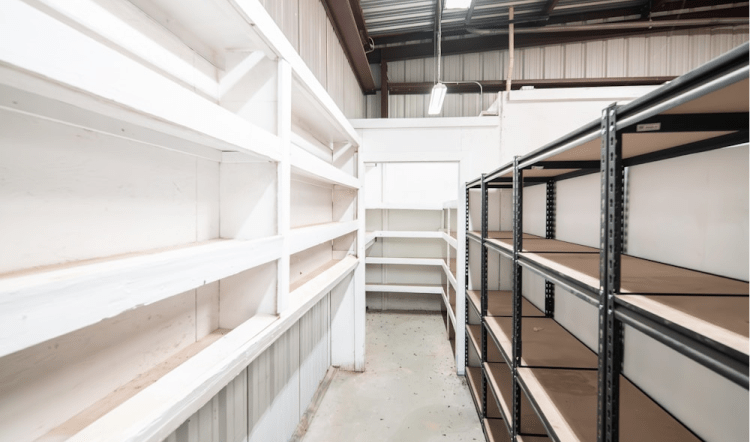Get a Free WorkTrek Demo
Let's show you how WorkTrek can help you optimize your maintenance operation.
Try for freeThe 5S principle is a key part of lean manufacturing and maintenance practices. It helps create clean, organized workspaces that boost safety and efficiency. The 5S system stands for Sort, Set in Order, Shine, Standardize, and Sustain – five steps that improve workplace organization and productivity.
This method can make a big difference in maintenance work. Technicians save time and avoid mistakes by keeping tools and parts tidy and easy to find.
A well-organized workspace also helps catch small issues before they become big problems, leading to less downtime and better-quality work.
The 5S approach pairs well with other systems like Total Productive Maintenance (TPM). Together, they create a culture of ongoing improvement in maintenance teams. This helps companies stay competitive and meet high standards for safety and quality.
Listen to this Article
History and Evolution of 5S
The 5S system, which has its roots in post-World War II Japan, has spread globally as a key part of lean manufacturing. It has changed how companies organize workspaces and maintain equipment.
Origins in Toyota Production System
The 5S method began at Toyota in the 1950s. It was part of the Toyota Production System, which aimed to boost efficiency and quality.
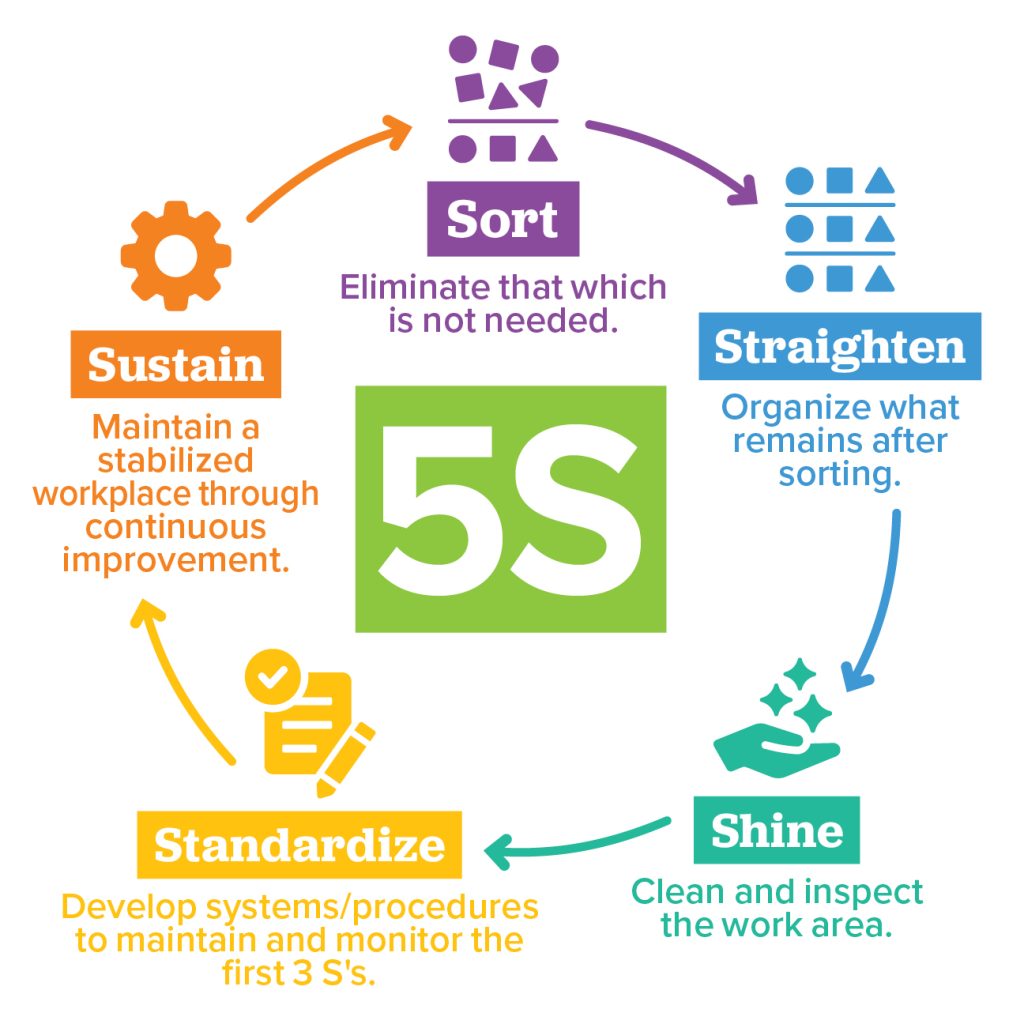
Source: Lean Construction
The system’s five steps all start with “S” in Japanese:
- Seiri (Sort)
- Seiton (Set in order)
- Seiso (Shine)
- Seiketsu (Standardize)
- Shitsuke (Sustain)
These steps helped Toyota cut waste and improve production. Workers kept their areas clean and organized. This made finding tools easier and spotting problems quicker.
Adoption in Lean Manufacturing
In the 1980s, 5S became a key part of lean manufacturing. Western companies saw how it helped Japanese firms and started using it, too.
5S fits well with lean ideas like cutting waste and constant improvement (kaizen). It made workplaces safer and more productive, and workers took pride in their clean, organized spaces.
Companies found 5S easy to start but hard to keep up with. It required everyone to change their habits, and managers had to lead by example and train staff well.
Global Influence
By the 1990s, 5S had spread worldwide. It moved beyond factories to offices, hospitals, and schools, and each industry adapted the system to fit its needs.
The service sector started using 5S later than manufacturing. However, it found a valuable method for organizing paperwork and digital files.
5S became a foundation for other improvement methods. It often comes before more complex systems are implemented, and many see it as a first step in changing workplace culture.
Today, 5S remains popular. It’s taught in business schools and used by companies of all sizes. Its simple ideas continue to help organizations work better and safer.
The Five Pillars of 5S
The First Pillar: Sort (Seiri)
Sort, or Seiri in Japanese, is the foundation of the 5S system. It involves identifying and removing unnecessary items from the workspace, which helps reduce clutter and improve efficiency.
Eliminating Unnecessary Items
Sorting begins with a thorough review of all items in the work area. Workers separate necessary from unnecessary items. They remove anything that’s not needed for current operations.
This process often reveals hidden problems. It exposes excess inventory, broken tools, and outdated materials. Teams use red tags to mark items for removal or evaluation.
Removing unneeded items frees up valuable space. It also makes finding and accessing essential tools and materials easier, leading to improved productivity and reduced waste.
Best Practices for Sorting
To sort effectively, teams should:
- Set clear criteria for keeping items
- Involve all team members in the process
- Be ruthless in eliminating waste
It’s important to sort items into categories:
- Keep: Essential for daily work
- Store: Needed occasionally
- Sell/Transfer: Useful elsewhere
- Scrap: No longer needed
Regular sorting sessions help maintain an organized workspace. Teams should schedule these sessions weekly or monthly to ensure the workplace stays clutter-free and efficient.
The Second Pillar: Set in Order (Seiton)
Set in Order, or Seiton, is about creating an organized workspace where everything has a designated place. This pillar focuses on efficient item arrangement and visual management to boost productivity.
Organizing Tools and Equipment
Set in Order aims to create a logical layout for tools and equipment. Each item gets a specific spot based on how often it’s used. Frequently used tools are placed within easy reach, and less common items go in less accessible areas.
A key part of organizing is using clear labels and markings. This helps workers quickly find what they need. Color coding is another helpful method. It can group similar items or show where things belong.
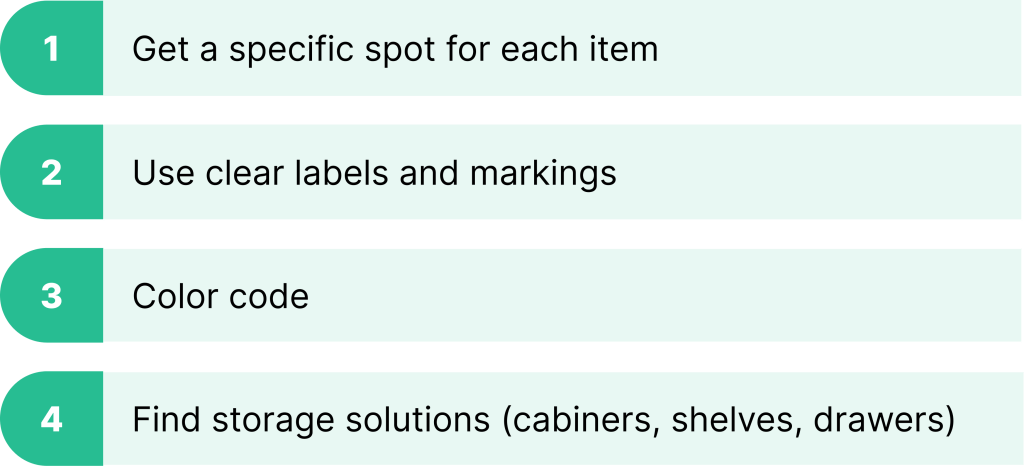
Source: WorkTrek
Storage solutions play a big role in Set in Order. Examples include:
- Tool cabinets
- Pegboards
- Drawer organizers
- Shelving units
These keep items tidy and easy to locate.
Use of Visual Management
Visual management makes the workspace more efficient. It uses visual cues to convey information quickly, reducing errors and saving time.
A popular visual management tool is the shadow board. It shows the outline of each tool, making it clear where items should be returned. This ensures tools are always in their proper place.
Other visual management techniques include:
- Floor markings to show walkways and work areas
- Colored bins for different types of materials
- Visual displays of work instructions or safety rules
These visual aids help maintain order and improve workflow efficiency.
The Third Pillar: Shine (Seiso)
Shine (Seiso) focuses on keeping the workplace clean and tidy. It promotes a safe, efficient environment and helps spot potential issues early.
Routine Cleaning and Maintenance
Shine involves regular cleaning of workspaces, tools, and equipment. This step goes beyond simple tidying. It includes deep cleaning and inspection of all areas.
Workers should clean their areas daily. This habit creates pride in the workspace. It also helps them spot problems quickly.
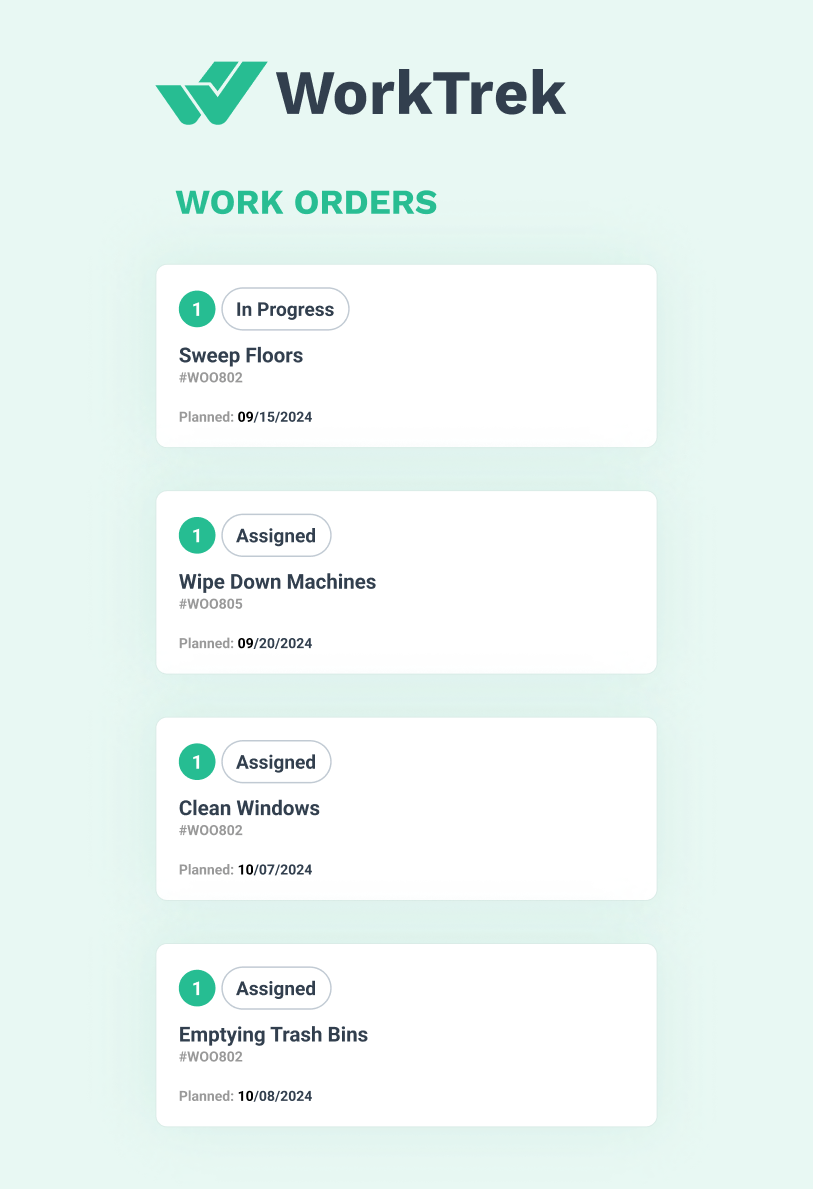
Source: WorkTrek
A cleaning checklist can be useful. It ensures no area is missed. The list might include:
- Sweeping floors
- Wiping down machines
- Cleaning windows
- Emptying trash bins
Regular cleaning makes the workplace safer. It reduces accidents from spills or clutter.
The Role of Cleaning in Preventive Maintenance
Cleaning is a key part of preventive maintenance. As workers clean, they can check for signs of wear or damage. This helps catch issues before they become big problems.
For example, wiping down a machine might reveal a small oil leak. Finding this early can prevent a major breakdown later.
Cleaning also extends equipment life. Dust and dirt can cause parts to wear faster, and regular cleaning helps machines run smoothly for longer.
A clean workspace makes it easier to spot when something is wrong. If a tool is missing or out of place, it’s more noticeable in a tidy area.
The Fourth Pillar: Standardize (Seiketsu)
Standardize (Seiketsu) builds on the first three pillars to create lasting change. It sets clear rules and expectations for maintaining a clean, organized workspace.
Developing Standard Operating Procedures
Standard operating procedures (SOPs) are key to the Standardize pillar. They spell out the best ways to do tasks and keep things in order.
SOPs ensure everyone follows the same steps, reducing mistakes and wasted time. Good SOPs are clear and easy to follow.
To make SOPs:
- Watch how tasks are done now
- Find the quickest, safest way
- Write down each step
- Test the steps and fix any issues
- Train workers on the new SOPs
Update SOPs when better ways are found. This helps a company keep getting better over time.
Visual Controls and Shadow Boards
Visual controls make it easy to see if things are where they should be. They help keep the workplace tidy without much effort.
Shadow boards are a great visual control. They show the outline of each tool, so it’s clear where everything goes.
Other visual controls include:
- Color-coding for different areas or tasks
- Floor markings to show where things belong
- Signs that explain procedures or safety rules
These tools make it simple to spot when something is out of place. Workers can quickly fix minor issues before they become big problems.
Visual controls also help new workers learn the system quickly. They can see how things should look at a glance.
The Fifth Pillar: Sustain (Shitsuke)
Sustain, or Shitsuke in Japanese is the final step in the 5S process. It focuses on keeping the other 4S practices going strong. This pillar aims to make 5S a normal part of daily work.
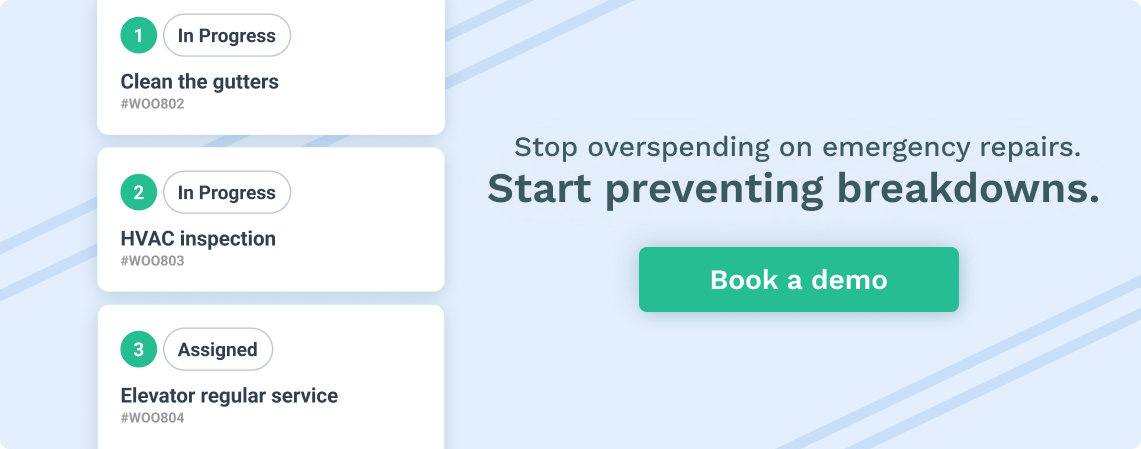
Creating a Culture of Discipline
Sustain means making 5S a habit. Workers must follow the new rules without being told, which takes time and effort. Leaders should set a good example by following 5S practices themselves.
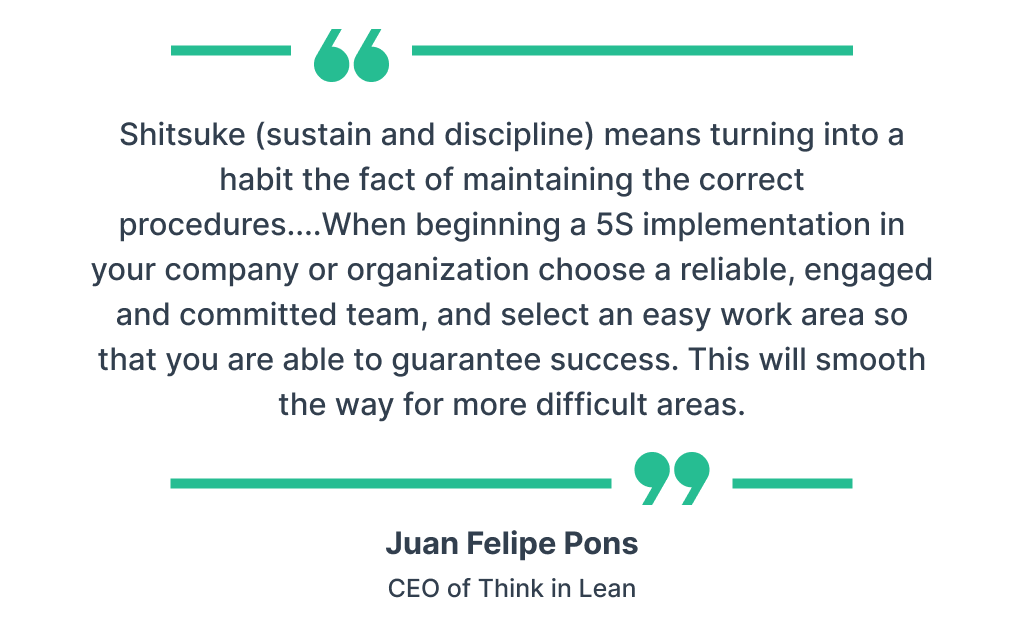
Illustration: WorkTrek / Quote: Lean Construction
Training is key. Regular classes help workers remember the 5S steps. Clear signs and posters can serve as reminders. Rewards for good 5S habits can boost employee morale.
Teams should meet often to discuss 5S. This keeps everyone on the same page and shows that 5S is important to the company.
Continuous Monitoring and Improvement
To keep 5S going, teams need to check their work. Regular audits help spot areas that need work, and these checks should happen on a set schedule.
Using key performance indicators (KPIs) can show if 5S is working. Some KPIs might be:
- Time saved
- Fewer accidents
- Less waste
- Higher output
Teams should set goals for these KPIs. They can then work to beat their old scores. This creates a spirit of friendly competition.
It’s vital to act on audit results. Quick fixes show that the company takes 5S seriously, helping create a culture of continuous improvement.
Implementing 5S in Maintenance
Implementing 5S in maintenance involves a structured approach to workplace organization and efficiency. This process includes assessing current conditions, planning the implementation, taking practical steps, and training employees.
Initial Assessment
To start implementing 5S in maintenance, a thorough evaluation of the current workplace is crucial. This assessment helps identify areas that need improvement.
Teams should examine tool storage, equipment layout, and overall workspace organization. They can create a checklist to document issues like clutter, inefficient storage, or safety hazards.
Taking photos of problem areas can provide visual references for before-and-after comparisons. This step establishes a baseline for measuring future progress.
Strategizing the Implementation Process
After the assessment, maintenance teams need to develop a clear strategy for 5S implementation. This plan should outline specific goals, timelines, and responsibilities.
Key steps include:
- Defining roles for team members
- Setting measurable targets
- Creating a timeline for each 5S phase
- Allocating resources for necessary changes
Implementing 5S principles requires careful planning to ensure success. Teams should prioritize areas that will have the most significant impact on efficiency and safety.
Practical Steps for Implementation
Implementing 5S in maintenance involves concrete actions for each of the five steps:
- Sort: Remove unnecessary items from the workspace.
- Set in Order: Organize tools and equipment for easy access.
- Shine: Clean the area and maintain cleanliness.
- Standardize: Create procedures for maintaining the first three S’s.
- Sustain: Develop habits to keep the system in place.
Teams should start with one area or department as a pilot project. This approach allows for testing and refining the process before expanding to other areas.
Regular audits help track progress and identify areas for improvement. Using visual aids like color-coding or labels can reinforce the new organization system.
Training and Engaging the Workforce
Employee training is vital for successful 5S implementation in maintenance. All staff should understand the principles and benefits of 5S.
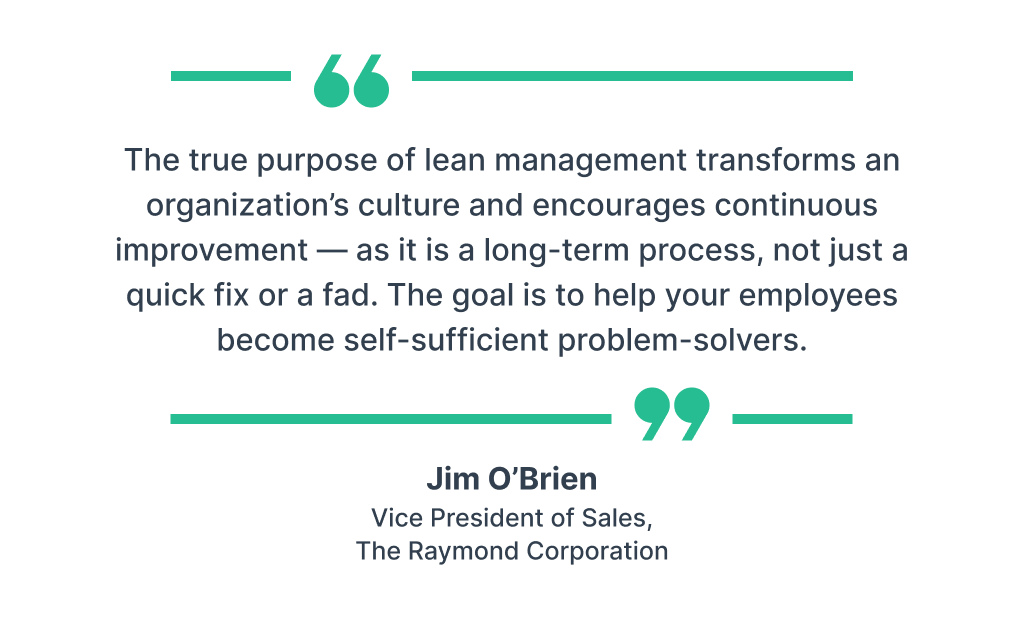
Illustration: WorkTrek / Source: Forbes
Training programs should cover:
- Basic 5S concepts
- Specific roles and responsibilities
- Proper use of new organization systems
- Importance of sustaining the changes
Engaging employees in the process fosters ownership and commitment. Encourage suggestions for improvement and recognize team members who contribute to the 5S efforts.
Regular meetings and updates keep everyone informed about progress and upcoming changes. This ongoing communication helps maintain momentum and enthusiasm for the 5S system.
Benefits of Integrating 5S
The 5S system brings many advantages to maintenance operations. It enhances safety, boosts efficiency, and drives operational excellence.
Enhanced Safety and Reduced Hazards
5S practices lead to safer workplaces. Proper organization removes clutter that can cause trips and falls.
Clear labeling of tools and equipment prevents misuse and accidents. Regular cleaning helps spot potential dangers early.
5S creates a culture of safety awareness. Workers become more mindful of their surroundings. They take an active role in keeping the workspace safe.
Reduced clutter means fewer fire hazards. It also improves emergency response times, as clear pathways allow for quick evacuations if needed.
Improved Workspace Efficiency
A well-organized workspace boosts productivity. Workers spend less time searching for tools and materials, and everything has a designated place.
5S streamlines processes by removing unnecessary items. This creates more space for value-adding activities.
Visual management techniques make work easier. Color-coding and clear labels speed up task completion.
Standardized work areas reduce errors. They also train new staff more quickly and effectively.
Regular cleaning and organizing become part of the routine. This ongoing effort maintains efficiency gains over time.
Operational Excellence
5S forms a foundation for broader operational improvements. It instills discipline and attention to detail in the workforce.
The system promotes a culture of continuous improvement. Workers are encouraged to spot and solve problems.
5S supports other lean initiatives like Total Productive Maintenance (TPM). It creates a clean, organized base for implementing advanced techniques.
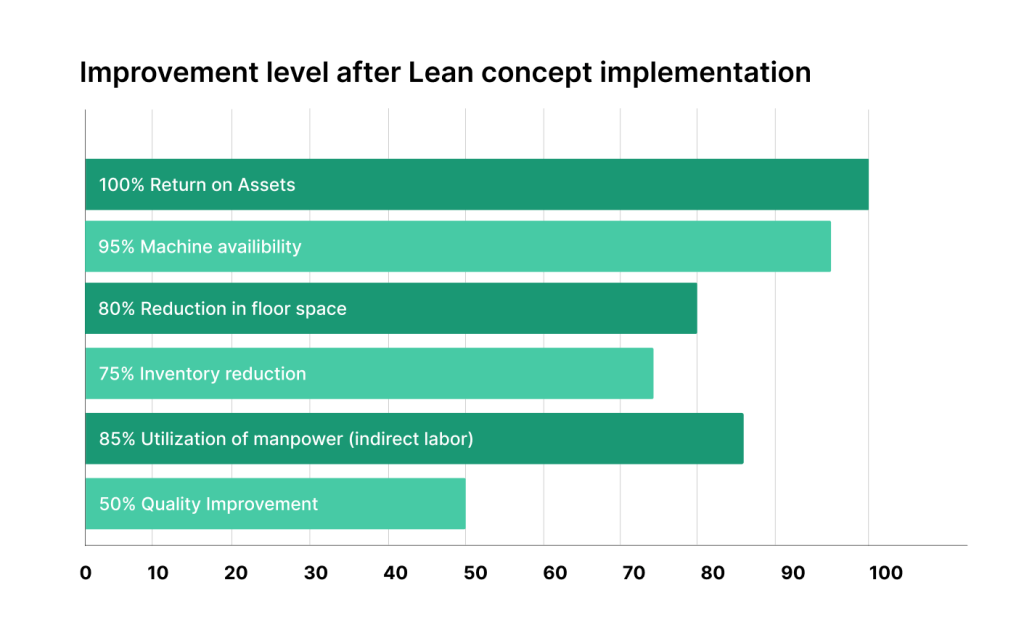
Illustration: WorkTrek / Data: Lean Manufacturing Implentation and Progress Measurement
Quality improves as errors and defects become more visible. Clean, orderly workspaces make it easier to spot issues early.
The 5S system also boosts employee morale. A well-maintained workplace shows respect for workers and their efforts.
Challenges and Solutions in 5S
Implementing 5S in maintenance faces several roadblocks. These issues range from employee resistance to lack of leadership support. Effective strategies can help overcome these challenges and lead to successful 5S adoption.
Common Roadblocks to Successful Implementation
Many organizations struggle with employee engagement when introducing 5S. Workers may resist change or fail to see the new system’s benefits. A lack of consistent leadership support can also hinder progress.
Time constraints often pose a challenge. Daily tasks may overwhelm maintenance teams, leaving little time for 5S activities. This can lead to incomplete implementation or backsliding into old habits.
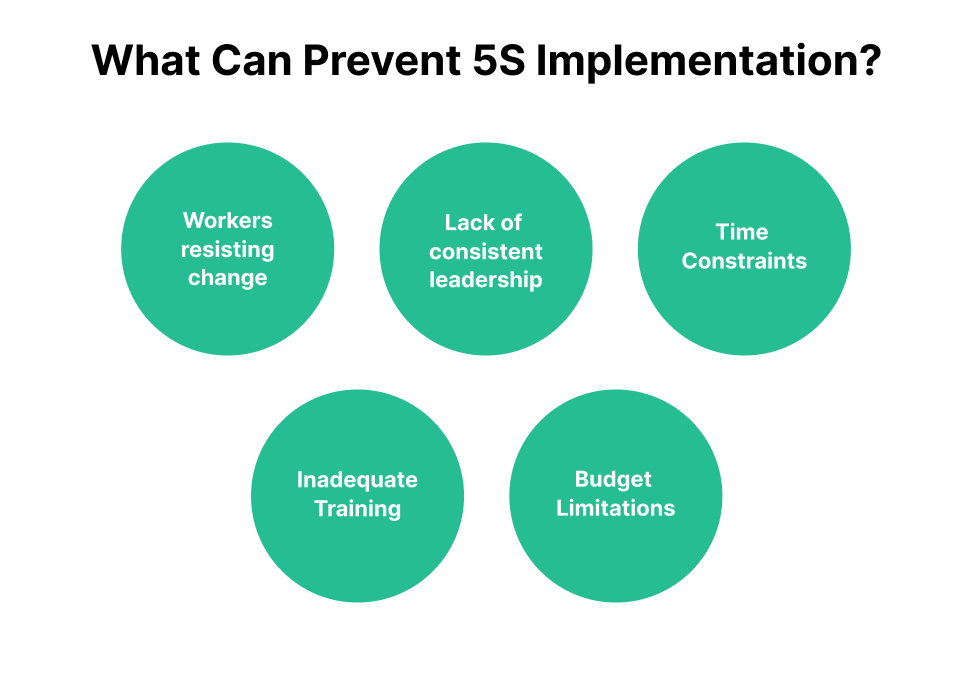
Source: WorkTrek
Inadequate training is another common issue. Without proper education, staff may misunderstand 5S principles or apply them incorrectly. This can result in ineffective practices and frustration.
Budget limitations can also impede 5S efforts. Proper storage solutions and cleaning supplies require investment, which some organizations may be reluctant to make.
Strategies to Overcome Challenges
Clear communication is key to overcoming resistance. Leaders should explain the benefits of 5S and how it will improve work conditions. Regular updates on progress can help maintain momentum.
Creating a dedicated 5S team can address time constraints. This group can focus on implementation and support other staff members. Setting aside specific time for 5S activities also helps prioritize the process.
Comprehensive training programs are essential. These should cover both the theory and practical application of 5S principles. Hands-on workshops can reinforce learning and build confidence.
Start with small, high-impact projects to demonstrate value. This can help justify further investment in 5S initiatives. Gradual implementation also allows for budget allocation over time.
Regular audits and recognition programs can sustain engagement. Celebrating successes, big and small, encourages continued participation and improvement.
Measuring 5S Performance
Tracking 5S performance is crucial for maintenance teams. It helps identify areas for improvement and ensures the system works well. Regular checks and clear goals are key parts of this process.
Defining Key Performance Indicators
Key Performance Indicators (KPIs) are vital for measuring 5S success. These metrics show how well a team follows 5S rules. Common KPIs include:
• Time saved in finding tools
• Reduced accident
• Increased productivity
• Improved quality of work

Source: WorkTrek
Teams should pick KPIs that fit their goals. For example, a factory might track how long it takes to find specific parts, or an office could measure desk cleanliness scores.
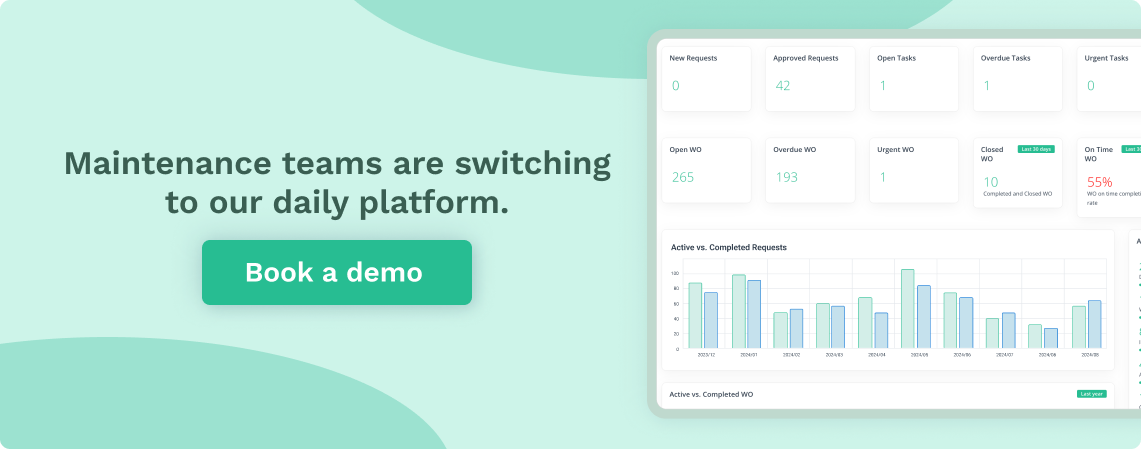
It’s best to start with a few key metrics. This makes it easier to focus on what matters most. As the 5S system grows, teams can add more KPIs.
Regular Audits and Assessments
Audits help maintain 5S standards over time. They should happen often, such as weekly or monthly. During an audit, a team checks each area against a set list.
A good audit form includes:
• Scores for each 5S step (Sort, Set, Shine, Standardize, Sustain)
• Space for comments
• Photos of good and bad examples
• Action items for improvement
Audits support continuous improvement by finding weak spots and showing which areas are doing well. This information helps teams know where to focus their efforts.
It’s important to share audit results with all workers. This keeps everyone informed and motivated to keep up good 5S habits.
5S Beyond Maintenance
The 5S principles extend far beyond just maintenance. These lean practices can improve many areas of an organization and help build a culture of continuous improvement.
Application in Other Organizational Areas
5S can benefit many departments outside of maintenance. In offices, 5S helps organize workspaces and digital files. This boosts productivity and reduces wasted time searching for documents.
Manufacturing areas use 5S to streamline production lines and reduce waste. Warehouses apply 5S to improve inventory management and order fulfillment.
Even customer-facing areas like retail stores use 5S. It keeps shelves stocked and organized, improving the shopping experience.
Healthcare facilities implement 5S to maintain cleanliness and efficiency. This is crucial for patient safety and care quality.
Building a Lean Culture
5S serves as a foundation for creating a lean organizational culture. It instills discipline and standardization across all levels.
Regular 5S audits keep everyone accountable. This builds habits that support continuous improvement efforts.
Visual management tools from 5S, like color coding and labels, make problems visible. Employees can quickly spot and fix issues.
5S encourages employee engagement. Workers take ownership of their work areas and suggest improvements. This bottom-up approach drives innovation and efficiency.
Leaders must model 5S behaviors to reinforce their importance. When management commits to 5S, it shows the entire organization its value.
Advanced 5S Tools and Techniques
Two key approaches help take 5S to the next level in maintenance settings. These methods use data and teamwork to boost equipment reliability and streamline maintenance tasks.
Total Productive Maintenance (TPM)
TPM is a system that aims to maximize equipment effectiveness. It involves operators and maintenance staff working together to keep machines running smoothly.
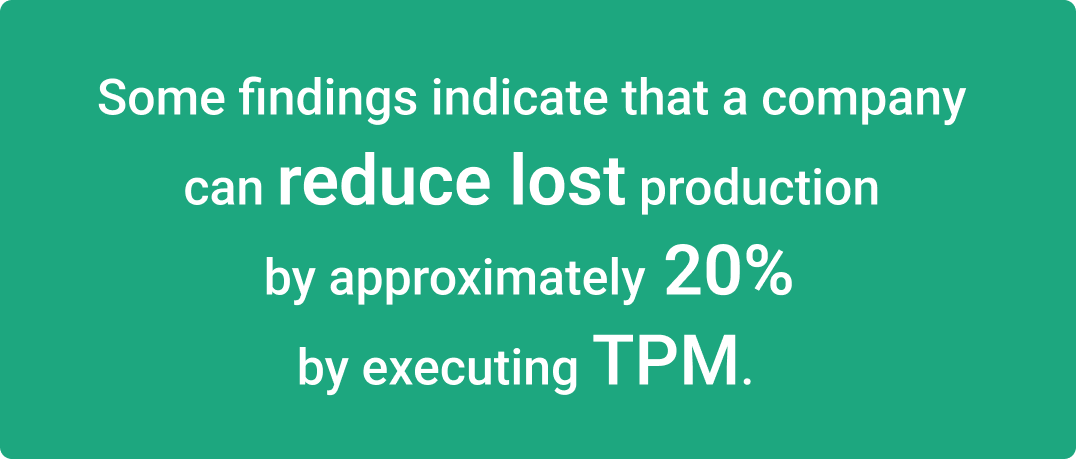 Illustration: WorkTrek / Data: Dynaway
Illustration: WorkTrek / Data: Dynaway
TPM has eight pillars:
- Autonomous maintenance
- Planned maintenance
- Quality maintenance
- Focused improvement
- Early equipment management
- Training and education
- Safety, health, and environment
- TPM in administration
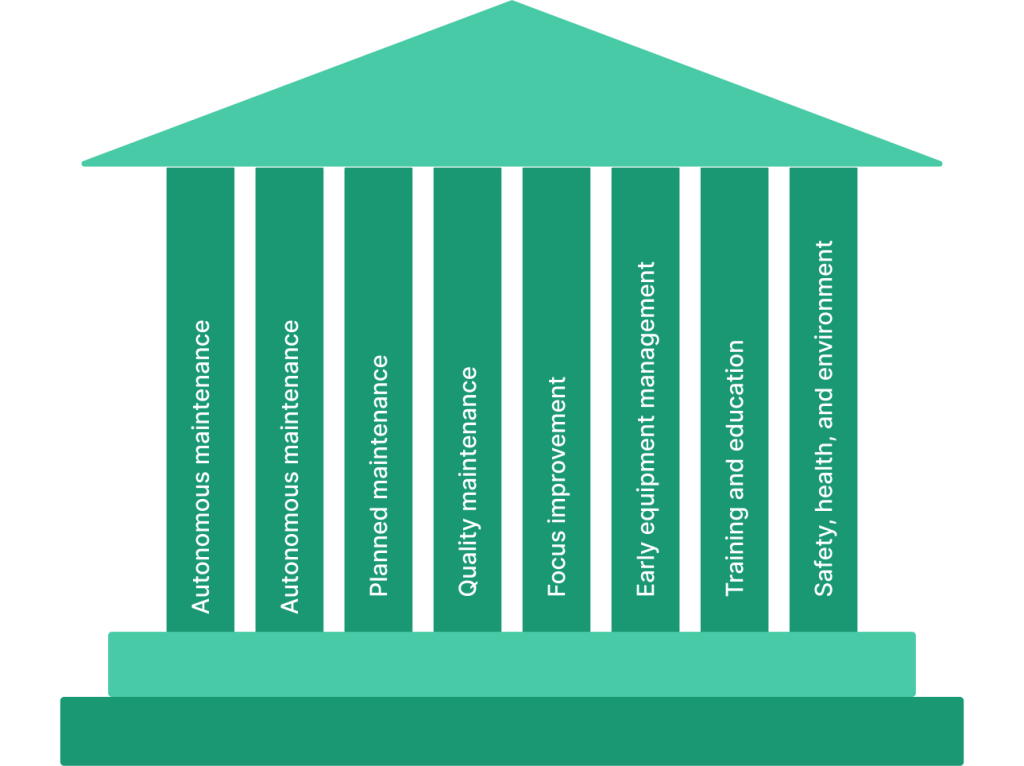
Source: WorkTrek
These pillars help reduce equipment failures and boost productivity. TPM empowers operators to handle basic upkeep tasks, freeing up maintenance teams for more complex work.
Computerized Maintenance Management Systems (CMMS)
CMMS software helps track and manage maintenance activities. It stores data on equipment, spare parts, and work orders. This digital tool makes it easier to plan and schedule maintenance tasks.
Key features of CMMS include:
- Asset tracking

Source: WorkTrek - Work order management

Source: WorkTrek - Preventive maintenance scheduling
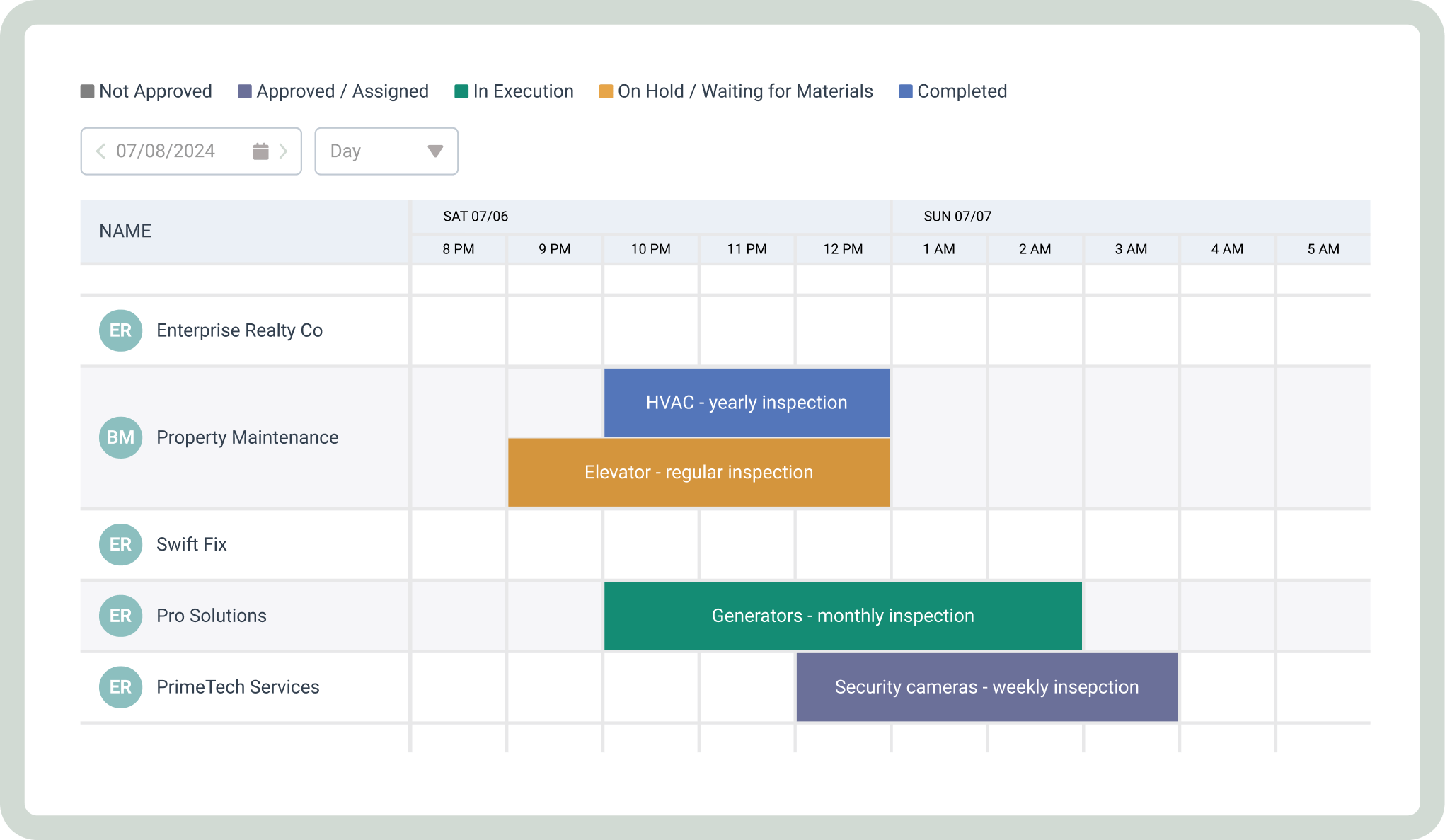 Source: WorkTrek
Source: WorkTrek - Inventory control
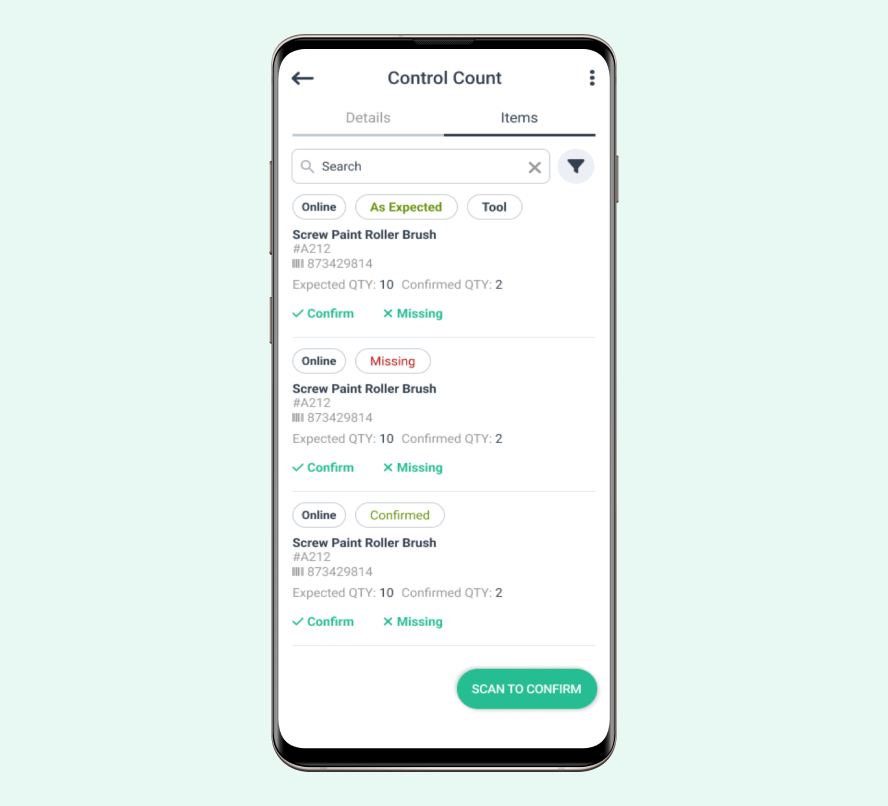
Source: WorkTrek - Reporting and analytics

Source: WorkTrek
CMMS helps maintenance teams work more efficiently. It reduces downtime by catching issues early. The system also provides data to make better equipment care and replacement decisions.
Future Trends in 5S and Maintenance
Innovation and technology shape the future of 5S and maintenance. These advancements aim to boost efficiency and streamline processes in workplaces.
Innovation and Evolving Practices
New approaches to 5S are emerging to meet changing workplace needs. Companies are adapting 5S principles to fit remote and hybrid work models, including digital organization tools and virtual workplace standards.
Lean maintenance practices are evolving to reduce costs and improve quality. Predictive maintenance, which uses data to forecast equipment needs before problems occur, is gaining traction.
Sustainability is becoming a key focus in 5S practices. Companies integrate eco-friendly methods into their sorting, setting, and shining processes.
The Role of Technology in 5S
Technology is transforming how organizations implement and maintain 5S principles. Smart sensors and Internet of Things (IoT) devices are being used to monitor workplace conditions and equipment status in real time.
Artificial intelligence and machine learning algorithms are helping to optimize maintenance schedules and identify areas for improvement in 5S practices.
Virtual and augmented reality tools are used for 5S training and to visualize optimal workplace layouts. These technologies make it easier for employees to understand and apply 5S concepts.
Mobile apps and cloud-based platforms are streamlining 5S audits and documentation processes, allowing for quicker issue identification and resolution.




